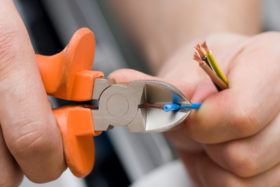Health & Safety on Site
Most of us are aware of the importance of health and safety on site, but few of us realise that the Construction (Design and Management) Regulations 2007 (CDM Regulations, in force from April 2007) have a legal implication for everyone involved in a project, and especially self-builders.
Health and safety – it’s the law…
New legislation now makes health and safety something that has to be physically planned into a project by all the parties involved, from concept to completion.
Do CDM 2007 regulations apply to all projects?
The CDM regulations provide for health and safety on any construction site where construction work is being carried out and affects all parties involved. The regulations’ definition of ‘Construction Work’ covers just about every type of project a self-builder could possibly consider undertaking – irrespective of whether or not they intend to physically get involved in the project. It doesn’t just cover the actual construction work but also the whole design and supervision process as well. The new regulations are divided into five parts:
- Part 1 deals with the application of the regulations and definitions.
- Part 2 covers general duties that apply to all construction projects.
- Part 3 contains additional duties that only apply to notifiable construction projects, that is those lasting more that 30 days or involving more than 500 person days of construction work (see panel).
- Part 4 contains practical requirements that apply to all construction sites.
- Part 5 contains the transitional arrangements and revocations.
Part 2 affects all self-builders
Essentially you cannot appoint a CDM co-ordinator, a designer, principal contractor, contractor or worker unless you have taken reasonable steps to ensure that the person to be appointed or engaged is competent to do the task requested or they are supervised by a ‘Competent Person’.
Every person involved in a project has a duty to cooperate and co-ordinate their actions regarding health and safety with those other persons around them who have joint responsibilities under the regulations.
Particular emphasis is placed on the principles of prevention.
A self-builder’s responsibility in relation to managing a project extends to ensuring sufficient time and resources are allocated to ensure construction work is carried out without risk to the health and safety of any one person.
You are also responsible for supplying relevant pre-construction information regarding health and safety factors affecting the site or construction work, for example, the proposed use of the structure as a workplace together with any time constraints on planning and preparation of the construction work.
Importantly, no contractor shall carry out construction work in relation to a project unless the client for the project is aware of his duties under the regulations.
When is a construction project ‘notifiable’ to HSE?
In the eyes of the regulations, most self-builders fall into the category of ‘Client’ and ‘Contractor’ as they tend to manage and sub-contract. This implies additional duties under the regulations where the project is notifiable (see above). If a project is notifiable and no one person has been appointed as the CDM co-ordinator, this role automatically falls to the client.
A project is notifiable to the Health and Safety Executive (HSE) if the construction phase will be longer than 30 days with 20 workers on site simultaneously at any point; or if 500 person days of construction work. An F10 form can be used and is available on the HSE website.
Where the project is notifiable, the CDM co-ordinator has to ensure that work does not start unless:
- The principal contractor has prepared a construction phase plan.
- Suitable welfare facilities have been put in place.
- The CDM co-ordinator prepares and regularly maintains a health and safety file that will be used to hold information relevant to ensure the health and safety of any person
Does the 30 days include weekends, bank holidays etc?
Any day on which construction work takes place is counted. What matters is how many days of construction work the project entails, not when these days occur.
What if a project is already underway?
The new CDM 2007 regulations will apply to projects that are already in progress. There are a number of provisions to aid the transition from the old duties to the new, for example, a planning supervisor or principal contractor already appointed under CDM 1994 will be deemed to be the CDM co-ordinator or principal contractor, but they must ensure that they acquire the new competencies within 12 months, if necessary.
Part 4 requirements affecting all sites
The HSE publishes information to help you identify what you must look out for, but here are some key pointers:
Safe place of work
You must provide and maintain a safe place of work at all times without risks to health, and with safe access and egress and a safe working environment taking into account machinery, equipment and hazards. Ensure that no person can gain access to an unsafe area.
Good order and site security
Every part of the site shall, as far as is practicable, be kept in good order and be kept in a reasonable state of cleanliness. The perimeter of a construction site should be fenced and suitable signs erected so that it is readily identifiable.
Stability of structures, demolition and dismantling
All practical steps shall be taken to prevent danger to any person, to ensure that any new or existing structure or any part that may become unstable during construction or demolition doesn’t collapse. In respect of demolition work, there must be a written plan prior to work commencing.
Excavations
Ensure steps are taken to avoid collapse of excavations, and falling materials, for example, spoil heaps are placed away from the excavation wall. Consider the loadings placed around the trenches by materials and equipment as these affect stability. Do not work in an unsupported open trench unless a competent person has deemed it safe.
Energy distribution installations
Energy distribution installations must be checked and clearly indicated. Power cables should be identified and routed away from the area of risk. Steps must be taken to prevent any risk from an underground service.
Prevention of drowning
This doesn’t just apply to water. You need to prevent a person from falling into any liquid, such as concrete.
Traffic routes and vehicles
Pedestrians and vehicles must be able to move safely without risks to health. Vehicles need to be used for their intended purpose only. Care needs to be taken when moving in confined areas or close to open earthworks.
Prevention of risk from fire
Suitable and sufficient steps need to be taken to prevent risk from fire and suitable emergency procedures need to be in place for dealing with a foreseeable emergency.
Fresh air, temperature/weather protection and lighting
You must provide relevant protective clothing, breathing apparatus and lighting to ensure health and safety.
Welfare facilities
You must provide sanitary conveniences, washing facilities, drinking water and rest facilities, and also a changing area if specific personal protective equipment is required.
Site insurance is essential
Site insurance, or more specifically employers’ liability and public liability, are a must on all self-build projects. An injured person, be it a worker, a friend lending a hand or a child injured or worse killed on a site will invariably involve legal costs and often a hefty award payment. Be aware that HSE can prosecute you and this can involve a legal action.
If you have employers’ liability cover, most site insurance policies will indemnify you in defending an action. The important thing to realise is that any such action brought against you is criminal, not civil and so any penalty or fine imposed is not normally insurable. This is why it’s essential you take your legal responsibilities very seriously.
Where to find out more
- The Absolutely Essential Health & Safety Toolkit for the Smaller Contractor (free from the Health & Safety Executive)
- The High 5: Five Ways to Reduce Risk on Site (free from the Health & Safety Executive).






























































































 Login/register to save Article for later
Login/register to save Article for later












Comments are closed.